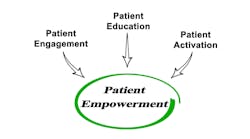Do Patients Electronically Access Their Health Data? A New Study Examines
Although hospitals are giving almost all of their discharged patients access to view, download, and transmit their health data, only about 10 percent of those with access are using it, according to research recently posted in Health Affairs.
Using nationwide data from 2,410 hospitals from 2014 to 2016, researchers—including notable health IT researcher Julia Adler-Milstein, Ph.D., at the University of California San Francisco (UCSF)— examined associations between patient- and hospital-level characteristics and access to and use of electronic health record (EHR) data among discharged patients. On average, hospitals gave 95 percent of discharged patients access to view, download, and transmit their information, but only about 10 percent of those with access used it—levels that were stagnant during the study period, the research revealed.
Access rates were highest among system-member, teaching, and for-profit hospitals. In contrast, access rates were lower for hospitals in the highest quartile for disproportionate share hospital status and for hospitals located in counties with high proportions of residents who were dually eligible for Medicare and Medicaid; use rates were lower for hospitals in counties with a high proportion of residents who were dually eligible, lacked computer or internet access, or were Hispanic, according to the data.
Evidence suggests that patients’ use of health information is associated with improved engagement, satisfaction, and convenience, even among vulnerable populations, the researchers noted. As such, they said, improving patients’ access to their electronic records has therefore become a cornerstone of patient advocacy efforts.
For example, policies from the Centers for Medicare and Medicaid Services (CMS) have mandated that hospitals seeking incentive payments must annually attest that they have met required thresholds on measures related to different domains of health IT adoption and use—including a measure in Meaningful Use Stage 2 that required hospitals to give patients online access to their medical records.
Specifically, the patient electronic access criteria required attesting hospitals to make patients’ health information accessible electronically for at least 50 percent of their patients and to demonstrate that at least one patient had used that capability to view, download, or transmit (to a third party) their information. The threshold for the view-download-transmit use measure was set to the bare minimum of just one single patient in response to providers’ concerns about their ability to influence patients’ behavior (for example, older or low-income patients might not have interest in accessing their data, or the ability to do so, through the standard approach of an online portal), the researchers explained.
How efforts can be improved
For this study, the researchers used this question as a key driver: To what extent are hospital structural characteristics and patient characteristics that reflect interest in promoting and ability to promote engagement with electronic health information associated with levels of access and use?
More than 2,400 hospitals that attested to achieving MU Stage 2 in 2016, and for at least two consecutive years during the 2014 to 2016 window, were examined for the study. The data showed that median performance in terms of the percentage of patients with the ability to access information was 93 percent in the first year of Medicare Stage 2 attestation and 95 percent in the second and third year. However, median performance in terms of the percentage of patients with access who used information was 12 percent in the first year, 11 percent in the second, and 10 percent in the third.
Overall, the researchers stated, the “findings suggest that policy efforts have failed to engage a large proportion of patients in the electronic use of their data or to bridge the ‘digital divide’ that accompanies healthcare disparities. Additional—possibly targeted—policy incentives, as well as higher thresholds for meeting the requirements of the Promoting Interoperability Program, merit policy makers’ consideration.”
What’s more, they said, hospitals are in a position to influence levels of patient portal access and use, and that they have the ability to “engage in system-level efforts that allay patients’ concerns about the confidentiality and privacy of patient portals.” Futher, organizations “can “use their market power to influence vendors to improve portal design to facilitate use for patients with low health literacy, technological literacy, or both,” the researchers said.
And when it comes to underserved populations who are less likely to have the ability to access information electronically, groups such as ethnic minorities are less likely to be offered access to a patient portal. Thus, despite high overall levels of access, there appears to be a need to address population-level barriers to access, according to the researchers.
They also pointed out that CMS, in an effort to appease providers, has not followed the original intent of the Meaningful Use program that was designed to give patients increased access to their electronic health data. “In 2012 the threshold for patient use was reduced from 10 percent to one patient, the current level at the time of this writing; and in 2018 the threshold for patient access was reduced from 50 percent to one patient, the current level for hospitals attesting after October 1, 2018. Our study suggests that a higher threshold for both measures might be more achievable than providers claim and that CMS may wish to reconsider this decision moving forward.”
They concluded, “It may also be valuable to consider more substantive measures of patient engagement with health information, given that the current use measure is satisfied if one patient simply logs into the portal on a single occasion. Examples of more meaningful measures may include the percentage of patients who, after discharge, exchange secure messages with their hospital team, transmit lab results to a third party, or assist in medication reconciliation by confirming their discharge medication list.”


